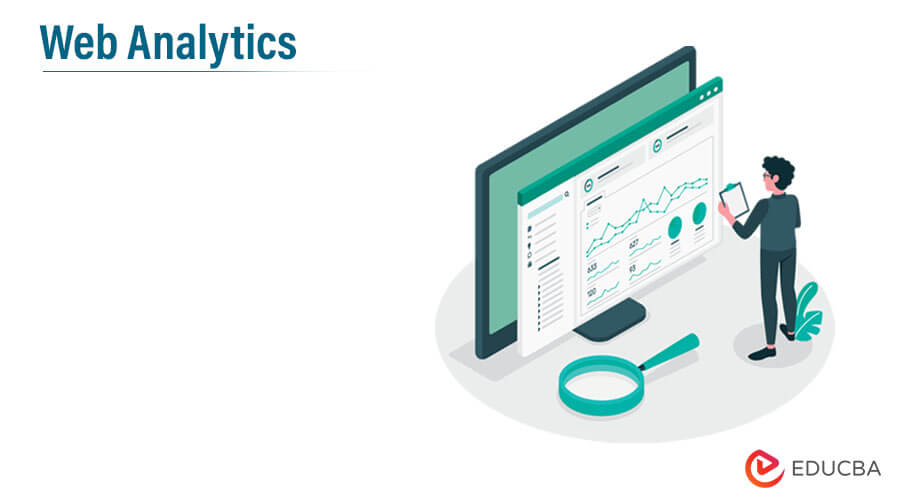Updated June 30, 2023
What is Web Analytics?
Web analytics is the collection, synthesis, and analysis of website data to improve user experience. It aims at business metrics for promoting specific products to customers who buy them and determining which products a particular customer is most likely to purchase. It can improve the ratio of revenue to marketing costs. Various web analytics tools automatically track key site performance metrics like conversion rate, bounce rate, monthly unique visitors, repeat visit rate, and more. Web analytics tools help brands achieve their goals systematically while simultaneously meeting and enhancing the customer’s needs.
Web analytics tools can help brand managers understand and enhance their knowledge about visitors coming to their page. This can help them better understand how customers interact with a particular website, which, in turn, can help them reach their goals effectively.
Implementing a proper analytics framework requires some basic level of foundation. There have to be some effective changes made in the management and strategy to meet the goals and challenges of the organization. To get started, here are five things that every web team should try to implement right away.
These include the following:
- Identify Key Performance Indicators (KPIs) and Micro Conversions (MCs)
- Use of events to track KPIs and MCs
- The outdoor marketing process to track campaigns in an effective manner
- Use of Market segmentation
- Create reports for appropriate actions based on the company’s goals.
The key elements among all this while developing an analytics framework are KPIs and MCs. Both of these elements can help brands to grow and truly empower themselves. By creating specific metrics, KPIs can help organizations determine the path to achieve their goals and objectives.
Better sales, newsletter subscriptions, contact form submissions, and higher organic traffic are key performance metrics that brands consider important for their overall growth and development. Brands need to understand their KPIs to work towards the company’s growth, or it will result in eventual failure.
According to Google evangelist Avinash Kaushik, good web analytics tools are something that every brand manager strives for. This strategic information helps brands decide whether they are performing well or dying a slow death.
Metrics are important but not always easy to decipher and comprehend. Brands must look ahead of their time to know their KPI metrics and start working on them as fast as possible. So the first question is, what is the primary purpose of our website, and what are we trying to achieve through this medium? When brands can answer these questions successfully, they not only can determine their key performance metrics but can also work on them in a way that makes it possible to achieve them systematically and easily.
If the brand perspective is that a website is a tool for prospective customers to learn about them or a medium for branding. In this case, this is a vague and unmeasurable answer. While they might be enough to get started on web analytics tools, they are not specific. On the other hand, if brands want their website to be a lead generation tool, they must set specific, measurable, and workable strategies. For example, if a prospective customer meets someone from your brand at a company, they will go home and visit their website. Customers who are impressed with the website are more likely to invest in the brand’s products and services.
All this means that once a brand has identified its key metric performance, it must correlate the actions taken after discovering the goal with the final results. If the main purpose of a brand’s website is to increase, its website leads, it is important to track whether the web page successfully closes the business deals for the brand.
Ultimately, the final impact will be based on employees connecting with the brand personally and intricately. It will help meet customer needs and also make better connections with brands.
Why are KPIs and MCs Important?
While it would be amazing if all visitors acted on KPIs, this is not always true. In fact, according to a study by Marketing Sherpa, only 10% of website visitors become actual sales. At the same time, the remaining 90% leave the website without making an actual sale. This is the reason why brand members must understand their micro-conversion elements. If brands had followed the prior process, they could understand their KPIs and those that were not. When a brand knows which performance indicators aren’t working, it can change to make them useful and help customers to convert their actions into sales.
KPIs and MCs are moving targets, so brand managers must use their resources and tactics wisely. This means that analyzing a particular website is a continuous process that requires dedicated time and effort. It is not something a brand can only do once and then forget.
With technology evolving, it is important to understand that tracking relevant information can become complex. However, many tools like Google Analytics can help brands achieve this goal systematically and comprehensively. It means that for successful web analytics tools, brand managers need to track the success of KPIs and MCs. For this, they need to track events. From a technical point of view, events are how visitors interact with a specific website after visiting a single page. Two examples of events are watching a video or clicking a link to another website. It means that setting up events can be helpful when brand managers have to bring together the analytical findings of their websites.
After deciding which tool can help the brand track its website, it can easily activate event tracking. In most cases, events require three categories: category, action, and label. This help brands distinguish between multiple events. The first part while tracking events is placing them in a category. All the videos on a website can be encompassed in a single category named videos. Similarly, all audio links can be put together under one category named podcasts.
While creating categories, it is important not to get extra creative and make it difficult to locate the same at a later stage. The only reason for creativity is when brands must distinguish between subcategories to analyze information. The second thing is action, which is self-explanatory. Users take This basic action on an event, for example, for a video that will be played or for a link that will be clicked. This is, again, something that can be done and easily. The label element is the event’s name, i.e., the title of the individual document. Once brand managers have decided on the above things, they can effectively analyze their websites.
Tracking Campaign in the Analytics Process
The next step in web analytics software is tracking campaigns, which is an integral part of understanding the website’s traffic. Once brand managers have started collecting their website data, particularly KPIs and MCs, this should help brands understand how visitors are coming to the website.
Many web analytics software has a basic overview to help brand managers understand the metrics. The three standard metrics include direct traffic, referral traffic from the outside website, and traffic from search engines. Understanding all these sources is important because they comprise only a part of the process. It is important to track other sources like email marketing, social media, and offline marketing. By collecting all this data, brand managers can get a complete picture of website traffic. Brands can then shift their focus on methods and techniques to help them deliver better outcomes and results.
By analyzing the data, brand managers will discover that visitors are likely to do certain things, depending on where they found the link to their website. For example, if a customer visits a page to sign up for a newsletter, the form will be the KPI for that brand. Through this form, a customer will build their relationship with the brand by requesting a quote, a demo, etc. So, if a company wants to increase its subscriptions by a certain number, the following strategies can be used:
- Add links to the subscription page to professional emails sent to customers.
- Start an email campaign to improve subscription rates.
- Use social media like LinkedIn and Twitter to promote the newsletter.
- Feature the newsletter on the homepage of the brand.
Campaign tracking can help in the first three tactics mentioned above to help brands reach their goals. The last step in web analytics software is the evaluation of the process. Brands must evaluate their web analytics software process to learn from their failures and success. As web analysts, they must provide valuable insights about how brands can learn effective management of resources like time, money, and people. It can also implement out-of-the-box and innovative strategies to develop brand power and loyalty.
Overall, this task requires high expertise from digital marketers and campaigners. It means that brand managers must clearly understand the problem and be creative to address it effectively. Massive data will finally make sense for businesses once thoroughly comprehended into appropriate segments. Finally, in creating a report, one can undeniably add immense value and benefits for brands in the true sense.
Recommended Articles
We hope that this EDUCBA information on “Web Analytics” was beneficial to you. You can view EDUCBA’s recommended articles for more information.



